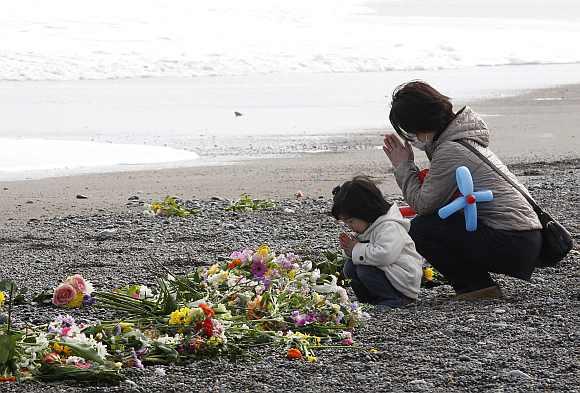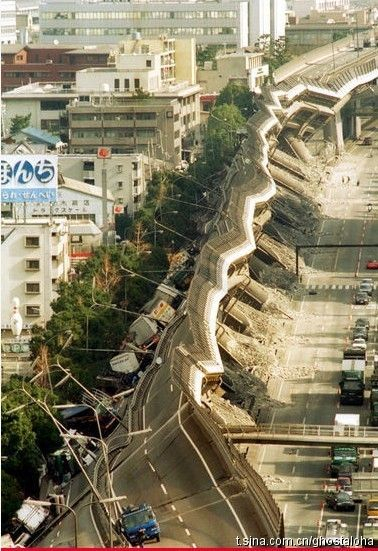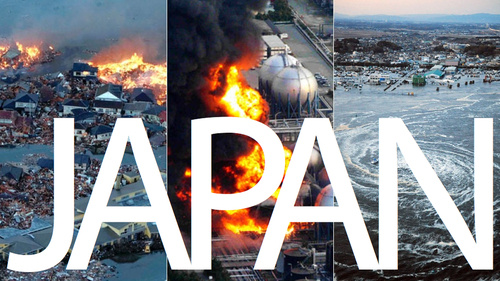東北地方太平洋沖地震
It is hard to believe that it has already been 3 years since the earthquake in Japan. Please keep Japan and all those who were affected by it in your prayers. Click any of the title links and it will take you to the main page where I found this article.Better understanding by watching this video. Even an aerial view of the tsunami making it's way to Japan.
When all of this happened I was at work eating lunch with a few colleagues, when all of a sudden, we heard all this commotion outside of the lunch room, saying 'bad news bad news', while others seem to be running down the hall. Everyone in the lunch room, quickly made their way to the several TV's in the meetings rooms, or the reception. As we got closer we heard an unusual chime on the news, followed by a warning of a large earthquake hitting northeastern Japan. I'm not sure if it was seconds, minutes later, but I asked my colleague, if we were in danger, he just said not to worry this happens all the time, jokingly. (This was actually the first time to experience an earthquake.) Just as I was going to tell him 'oh I see', our building in the business district in central Tokyo started swaying. For a few seconds, we stood there, looking at each other, noticing office building across from us moving from left to right, everyone was quiet, then in a few seconds, the swaying became so violent we had to hold on to something. I was standing at the back corner of the room next to a window, I immediately bent down; that's when my colleague started pulling me away from the window and telling me to get near the wall. The scariest part was being on the 34th floor and seeing a large construction crane swaying from side to side on a taller building next door. Some of the colleagues rushed to open the doors to secure exit routes. Others were in tears. We kept feeling aftershocks. As we looked down, we saw people streaming out of office buildings, and gathering in a plaza with wide open space. Shaking continued for a long time, at least it felt that way, I prayed so hard! Attempts to call family members on the cellphone and landlines failed. My Windows Phone and I Phone turned out be useless. I wasn’t receiving any emails, and I wasn’t able to send anything. When everything seemed to stop, everyone started to rush out of the building; I went back to my office got my keys and my backpack, checked one final time the internet at my computer, it finally went thru, but was not able to contact anyone who I knew in Japan, or my family overseas, so I just posted on Facebook and any other profile that I was OK, and that I was on my way home, and notified them to not worry if it takes me a while to get home. Afterwards I made my way outside of the building. It was so crowded! After seeing the news and talking to people I turned to the parking garage, where my mini cooper was parked with my bike (usually used to run errands), but traffic was bad usually, but that day, even more so since everyone was driving really slow, plus no trains, I ended up getting my bike and riding all the way home.
Here's a look at what you need to know about the earthquake and tsunami that struck Japan in March of 2011.
March 11, 2011 - At 2:46pm, a 9.0 magnitude earthquake takes place 231 miles northeast of Tokyo, Japan, at a depth of 15.2 miles. Duration: Approximately 6 minutes.
The earthquake causes a tsunami with 30 ft waves that damage several nuclear reactors in the area.
It is the fourth largest earthquake on record (since 1900) and the largest to hit Japan.


March 11, 2011 - At
2:46pm, an 8.9 magnitude earthquake takes place 231 miles northeast of
Tokyo, Japan. (8.9 = original recorded magnitude; later upgraded to 9.0)
(0:46 ET/5:46 GMT)
- The Pacific Tsunami Warning Center issues a tsunami warning for the Pacific Ocean from Japan to the U.S. About an hour after the quake, waves up to 30 ft high hit the Japanese coast, sweeping away vehicles, causing buildings to collapse, and severing roads and highways.
- The Japanese government declares a state of emergency for the nuclear power plant near Sendai, 180 miles from Tokyo. Sixty to seventy thousand people living nearby are ordered to evacuate to shelters.
- The Pacific Tsunami Warning Center issues a tsunami warning for the Pacific Ocean from Japan to the U.S. About an hour after the quake, waves up to 30 ft high hit the Japanese coast, sweeping away vehicles, causing buildings to collapse, and severing roads and highways.
- The Japanese government declares a state of emergency for the nuclear power plant near Sendai, 180 miles from Tokyo. Sixty to seventy thousand people living nearby are ordered to evacuate to shelters.

March 12, 2011 - Overnight, a 6.2 magnitude aftershock hits the Nagano and Niigata prefecture (USGS).
- At 5:00am, a nuclear emergency is declared at Fukushima Daiichi nuclear power plant. Officials report the earthquake and tsunami have cut off the plant's electrical power, and that backup generators have been disabled by the tsunami.
- Another aftershock hits the west coast of Honshu - 6.3 magnitude. (5:56am)
- The Japanese Nuclear and Industrial Safety Agency announces that radiation near the plant's main gate is more than eight times the normal level.

- At least six million homes - 10 percent of Japan's households - are without electricity, and a million are without water.
- The US Geological Survey says the quake appears to have moved Honshu, Japan's main island, by 8 feet and has shifted the earth on its axis.
- About 9,500 people - half the town's population - are reported to be unaccounted for in Minamisanriku on Japan's Pacific coast.

March 13, 2011 - People living within 10km (6.2 miles) of the Fukushima Daini and 20km of the Fukushima Daiichi power plants begin a government-ordered evacuation. The total evacuated so far is about 185,000.
- 50,000 Japan Self-Defense Forces personnel, 190 aircraft and 25 ships are deployed to help with rescue efforts.
- A government official says a partial meltdown may be occurring at the damaged Fukushima Daiichi plant, sparking fears of a widespread release of radioactive material. So far, three units there have experienced major problems in cooling radioactive material.
March 14, 2011 - The
U.S. Geological Survey upgrades its measure of the earthquake to
magnitude 9.0 from 8.9. The new reading means the quake is the fourth
strongest earthquake since 1900.
- An explosion at the Daiichi plant No. 3 reactor causes a building's wall to collapse, injuring six. The 600 residents remaining within 30 kilometers of the plant, despite an earlier evacuation order, have been ordered to stay indoors.
- The No. 2 reactor at the Daiichi plant loses its cooling capabilities. Officials quickly work to pump seawater into the reactor, as they have been doing with two other reactors at the same plant, and the situation is resolved. Workers scramble to cool down fuel rods at two other reactors at the plant - No. 1 and No. 3.
 - Rolling blackouts begin in parts of Tokyo and eight prefectures.
Downtown Tokyo is not included. Up to 45 million people will be affected
in the rolling outages, which are scheduled to last until April.
- Rolling blackouts begin in parts of Tokyo and eight prefectures.
Downtown Tokyo is not included. Up to 45 million people will be affected
in the rolling outages, which are scheduled to last until April.
- An explosion at the Daiichi plant No. 3 reactor causes a building's wall to collapse, injuring six. The 600 residents remaining within 30 kilometers of the plant, despite an earlier evacuation order, have been ordered to stay indoors.
- The No. 2 reactor at the Daiichi plant loses its cooling capabilities. Officials quickly work to pump seawater into the reactor, as they have been doing with two other reactors at the same plant, and the situation is resolved. Workers scramble to cool down fuel rods at two other reactors at the plant - No. 1 and No. 3.

March 15, 2011 -
The third explosion at the Daiichi plant in four days damages the
suppression pool of reactor No. 2, similar to an explosion occurring at
No. 1 over the weekend. Water continues to be injected into "pressure
vessels" in order to cool down radioactive material.
March 16, 2011 - The
nuclear safety agency investigates the cause of a white cloud of smoke
rising above the Fukushima Daiichi plant. Plans are canceled to use
helicopters to pour water onto fuel rods that may have burned after a
fire there, causing a spike in radiation levels. The plume is later
found to have been vapor from a spent-fuel storage pool.
- In a rare address, Emperor Akihito tells the nation to not give up hope, that "we need to understand and help each other." A televised address by a sitting emperor is an extraordinarily rare event in Japan, usually reserved for times of extreme crisis or war.
 - After hydrogen explosions occur in three of the plant's reactors
(1,2, and 3), Chief Cabinet Secretary Yukio Edano says radiation levels
"do not pose a direct threat to the human body" between 12 to 18 miles
(20 to 30 kilometers) from the plant.
- After hydrogen explosions occur in three of the plant's reactors
(1,2, and 3), Chief Cabinet Secretary Yukio Edano says radiation levels
"do not pose a direct threat to the human body" between 12 to 18 miles
(20 to 30 kilometers) from the plant.
- In a rare address, Emperor Akihito tells the nation to not give up hope, that "we need to understand and help each other." A televised address by a sitting emperor is an extraordinarily rare event in Japan, usually reserved for times of extreme crisis or war.

March 17, 2011 - Gregory
Jaczko, head of the Nuclear Regulatory Commission, tells U.S. Congress
spent fuel rods in the No. 4 reactor have been exposed because there "is
no water in the spent fuel pool," resulting in the emission of
"extremely high" levels of radiation.
- Helicopters operated by Japan's Self-Defense Forces begin dumping tons of seawater from the Pacific Ocean on to the No.3 reactor to reduce overheating.
 - Radiation levels hit 20 millisieverts per hour at an annex
building where workers have been trying to re-establish electrical
power, "the highest registered (at that building) so far," (TEPCO)
- Radiation levels hit 20 millisieverts per hour at an annex
building where workers have been trying to re-establish electrical
power, "the highest registered (at that building) so far," (TEPCO)
- Helicopters operated by Japan's Self-Defense Forces begin dumping tons of seawater from the Pacific Ocean on to the No.3 reactor to reduce overheating.

March 18, 2011 -
Japan's Nuclear and Industrial Safety Agency raises the threat level
from four to five, putting it on a par with the 1979 Three Mile Island
accident in Pennsylvania. The International Nuclear Events Scale says a
Level Five incident means there is a likelihood of a release of
radioactive material, several deaths from radiation and severe damage to
the reactor core.
April 12, 2011 - Japan's
nuclear agency raises the Fukushima Daiichi crisis from Level 5 to a
Level 7 event, the highest level, signifying a "major accident". It is
now on par with the 1986 Chernobyl disaster in the former Soviet Union,
which amounts to a "major release of radioactive material with
widespread health and environmental effects requiring implementation of
planned and extended countermeasures."


June 6, 2011 - Japan's
Nuclear Emergency Response Headquarters reports that reactors 1, 2 and 3
at the Fukushima Daiichi nuclear power plant experienced a full
meltdown.
June 30, 2011 - The
Japanese government recommends more evacuations of households 50 to 60
km northwest of the Fukushima Daiichi power plant. The government said
higher radiation is monitored sporadically in this area.


July 16, 2011 - Kansai
Electric announces that a reactor at the Ohi nuclear plant will be shut
down due to problems with an emergency cooling system. This leaves only
18 of Japan's 54 nuclear plants producing electricity.
October 31, 2011 -
In response to questions about the safety of decontaminated water,
Japanese government official Yasuhiro Sonoda drinks a glass of
decontaminated water taken from a puddle at the Fukushima Daiichi
nuclear plant.
November 2, 2011 -
Kyushu Electric Power Co. announces that it restarted No. 4 reactor,
the first to come back online since the March 11 disaster, at the Genkai
nuclear power plant in western Japan.
November 17, 2011 - Japanese
authorities announce that they have halted the shipment of rice from
some farms northwest of the Fukushima Daiichi nuclear power plant after
finding higher-than-allowed levels of radioactive cesium.


December 5, 2011 - Tokyo
Electric Power Company announces that at least 45 metric tons of
radioactive water have leaked from the Fukushima Daiichi nuclear
facility, and may have reached the Pacific Ocean.
December 16, 2011 - Japan's
Prime Minister says that a "cold shutdown" has been achieved at the
Fukushima Daiichi nuclear power plant, a symbolic milestone that means
the plant's crippled reactors have stayed at temperatures below the
boiling point for some time.


December 26, 2011 -
Investigators report that poorly trained operators at the Fukushima
Daiichi nuclear power plant misread a key backup system and waited too
long to start pumping water into the units, according to an interim
report from the government committee probing the nuclear accident.
February 27, 2012 - Rebuild
Japan Initiative Foundation, an independent fact-finding committee,
releases a report claiming that the Japanese government feared the
nuclear disaster could lead to an evacuation of Tokyo while at the same
time hiding its most alarming assessments of the nuclear disaster from
the public as well as the United States.
May 24, 2012 -
TEPCO (Tokyo Electric Power Co.) estimates about 900,000 terabecquerels
of radioactive materials were released between March 12 and March 31 in
2011, more radiation than previously estimated.
June 11, 2012 -
1,324 Fukushima residents lodge a criminal complaint with the Fukushima
prosecutor's office, naming Tsunehisa Katsumata, the chairman of Tokyo
Electric Power Co. (TEPCO) and 32 others responsible for causing the
nuclear disaster that followed the March 11 earthquake and tsunami and
exposing the people of Fukushima to radiation.


June 16, 2012 -
Despite public objections, the Japanese government approves restarting
two nuclear reactors at the Kansai Electric Power Company in Ohi in
Fukui prefecture, the first reactors scheduled to resume since all
nuclear reactors were shut down in May 2012.
July 1, 2012 -
Kansai Electric Power Co. Ltd. (KEPCO) restarts the Ohi nuclear plant's
No. 3 reactor, resuming nuclear power production in Japan for the first
time in the wake of the Fukushima Daiichi meltdown following the
tsunami.
July 5, 2012 - The
Fukushima Nuclear Accident Independent Investigation Commission's
report finds that the Fukushima Daiichi nuclear crisis was a "man-made
disaster" that unfolded as a result of collusion between the facility's
operator, regulators and the government. The report also attributes the
failings at the plant before and after March 11 specifically to Japanese
culture.
http://warp.da.ndl.go.jp/info:ndljp/pid/3856371/naiic.go.jp/en/
July 23, 2012 - A
Japanese government report is released criticizing TEPCO. The report
says that the measures taken by TEPCO to prepare for disasters were
"insufficient," and the response to the crisis "inadequate."
October 12, 2012 -
TEPCO acknowledges in a report that it played down safety risks at the
Fukushima Daiichi power plant out of fear that additional measures would
lead to a plant shutdown and further fuel public anxiety and
anti-nuclear movements.


July 2013 -
TEPCO admits that radioactive groundwater is leaking into the Pacific
Ocean from the Fukushima Daiichi site, bypassing an underground barrier
built to seal in the water.
August 28, 2013 - Japan's nuclear watchdog Nuclear Regulation Authority (NRA)
says a toxic water leak at the tsunami-damaged Fukushima Daiichi power
plant has been classified as a level 3 "serious incident" on an
eight-point International Nuclear Event Scale (lINES) scale.
September 15, 2013 - Japan's only operating nuclear reactor is shut down for maintenance. All 50 of the country's reactors are now offline. The government hasn't said when or if any of them will come back on.


November 18, 2013 - Tokyo
Electric Power Co. (TEPCO) says that operators of the Fukushima nuclear
plant have started removing 1,500 fuel rods from damaged reactor No. 4. It is considered a milestone in the estimated $50 billion cleanup operation.
February 20, 2014 -
TEPCO says an estimated 100 metric tons of radioactive water has leaked
from a holding tank at the Fukushima Daiichi Nuclear Power Plant.
Japan Tsunami Debris:
The Japanese government estimates that the tsunami swept about five million tons of debris offshore, but that 70 percent sank, leaving 1.5 million tons floating in the Pacific Ocean.
The Japanese government estimates that the tsunami swept about five million tons of debris offshore, but that 70 percent sank, leaving 1.5 million tons floating in the Pacific Ocean.
The debris is most likely not radioactive. It is no longer in a "debris field," but scattered across a large area of the North Pacific.






Invest in Ripple on eToro the World's Leading Social Trading Network...
ReplyDeleteJoin 1,000,000's who have already discovered easier methods for investing in Ripple.
Learn from established eToro traders or copy their positions automatically!